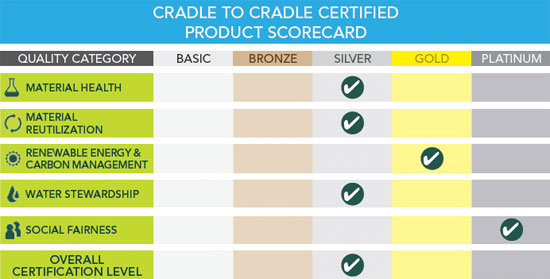Multi-Attribute Certification Pinpoints True Sustainability
The Framework—A Continuous Improvement Standard
Companies pursuing certification are asked to follow a strict process that includes inventory and assessment in five areas including Material Health, Material Reutilization, Renewable Energy and Carbon Management, Water Stewardship, and Social Fairness, and to develop a plan to design and optimize their products towards the goal of being safe, healthy, and regenerative. The program recognizes that manufacturers may be at different levels of optimization, and it allows those seeking certification to enter the program at various levels and make a commitment to continuous improvement and optimization. Products are recertified every two years.
System Overview
Cradle to Cradle Certified is a multi-attribute approach to certification of a wide range of products, with an emphasis on the built environment, fashion, and personal care products. In order to achieve certification, a product must meet the requirements for a given level in all of the following five categories:
 |
The minimum level of achievement in any of the five categories ultimately determines the final certification level. Chart courtesy of Cradle to Cradle Products Innovation Institute |
• Material Health. Identifying, managing, and, where possible, replacing substances of concern with ones that are safe and healthy for humans and the environment.
• Material Reutilization. Designing products so all materials can be re-used safely by nature or industry.
• Renewable Energy and Carbon Management. Assembling and manufacturing products with renewable, non-polluting energy.
• Water Stewardship. Making products in ways that protect and enrich water supplies.
• Social Fairness. Treating all the people involved in the product manufacturing process in socially responsible ways.
Levels of Certification
Because the program is not based on the binary, pass/fail model, but instead certifies the intention to continuously improve, the certification results are split into a five-level system of Basic, Bronze, Silver, Gold, and Platinum. A scorecard is created to rate the product on all certification criteria. Each criterion is assigned a level of achievement. The minimum level of achievement in any of the five categories ultimately determines the final certification level. A product may be “Gold” or even “Platinum” in one or two categories but “Silver” in three others, making the overall product certification “Silver.” The applicant is expected to optimize each aspect of their product over time, with the ultimate goal being to encourage innovation and the design of products that effectively and positively impact people and the environment.









